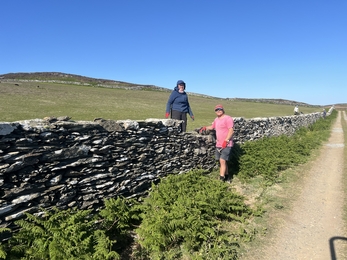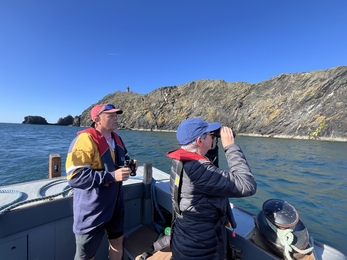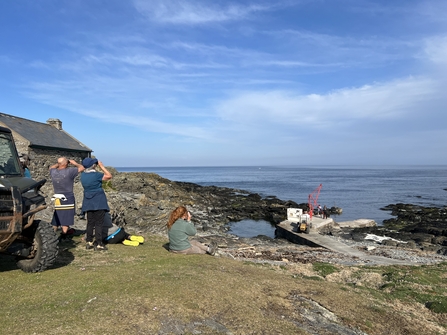Summer has arrived early on the Calf, with the month of May bringing fine weather, exciting days, fresh faces, and an explosion of new life. The Swallows have returned, the Bluebells have been in bloom, the Bracken is shooting up, eggs are hatching, and insect life is striding into focus. The Estate Team and volunteers have been hard at work preparing and maintaining the Observatory and island in expectation of the coming guest season, conducting various biodiversity surveys and related projects, welcoming journalists and film crews, and generally enjoying the bustling life of the Calf in the warm early summer.
The month began with the Calf hosting a film crew shooting several scenes for an upcoming thriller “The Catch”, starring John Rhys-Davies and Lucy Russell. The film crew shot scenes at South Harbour and at the beautiful historic lighthouses. Stephen and Quentin, the captain and crew of the Scraayl out of Port St. Mary through whom visitors can arrange trips to and around the Calf, made special guest appearances. A journalist from the BBC also visited the Calf intending to write a piece on small island life. His finished article can be found here: https://www.bbc.com/travel/article/20250523-calf-of-man-uk-island-off-limits-for-half-the-year.
Manx National Heritage have an ongoing project of Fixed-Point Photography on the Calf. Photographs are taken in fixed positions and orientations at set times of year to portray how the island changes through and over the year. This has involved traipsing across the wild landscape of the Calf following shaky written direction such as “Stand near the obvious rocky outcrop” and taking landscape photographs, but also this time noting down GPS coordinates and elevations to ease future efforts. The project has been running for decades, and it is hoped that these images will one day illuminate how the Calf of Man has changed over the years, and how it fluctuates through a year, but we also aim to catalogue and preserve the scenery of the Calf.
As mentioned in our previous blog post, we have had several volunteers over on the Calf. Matt and Cathy, our resident Aussies have been instrumental in conducting our longtail camera trap checks, as well as working very hard in the garden removing the potentially invasive pendulous sedge grass, not to mention getting stuck in with all aspects of the Estate teams day-to-day. Rebecca has been over on the Calf surveying and mapping Eider duck nests, as well as lending a hand with bird ringing and surveying other native biodiversity.











